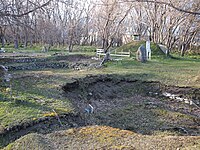
Photo from wikipedia
Abstract The East African Rift system created one of the world's most obsidian-rich landscapes, where this volcanic glass has been used to make tools for nearly two million years. In… Click to show full abstract
Abstract The East African Rift system created one of the world's most obsidian-rich landscapes, where this volcanic glass has been used to make tools for nearly two million years. In Kenya alone, there are > 80 chemically distinct obsidians along a 800-km north-south transect. Recently Brown et al. (2013) published their Kenyan obsidian database assembled since the 1980s. Specifically, they report elemental data measured by EMPA, ICP-MS, and WDXRF, providing a rich basis for future sourcing studies. Here we report our use of portable XRF (pXRF), calibrated specifically and directly to the database in Brown et al. (2013), to examine interactions between Later Stone Age forager-fishers and pastoralists near Lake Victoria. Regarding our calibration to the WDXRF and EMPA datasets of Brown et al. (2013), the elements of interest have very high correlations (R 2 = 0.96–0.99) to our pXRF values, which show, on average, only a 2–5% relative difference from the published values. Use of pXRF data specifically calibrated to the datasets from Brown et al. (2013) greatly expands the impact of their work over three decades to catalog and characterize a multitude of Kenyan obsidians. Our focus here is investigating social contacts and exchange between late Holocene populations that included Kansyore forager-fishers and Elmenteitan pastoralists. Similarities and differences in their obsidian access provide new insights into long-term interactions between foragers and food producers in eastern Africa. We report new sourcing results for obsidian artifacts from six late Holocene rock shelters along the Winam Gulf of Lake Victoria. The patterns in obsidian access are consistent with changing interaction spheres that are relevant to understanding forager-fisher social identities and subsistence strategies during periods of economic and demographic change.
Journal Title: Journal of Archaeological Science: Reports
Year Published: 2017
Link to full text (if available)
Share on Social Media: Sign Up to like & get
recommendations!